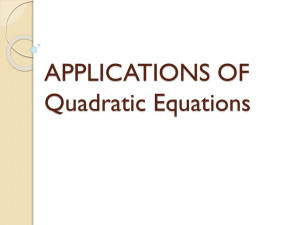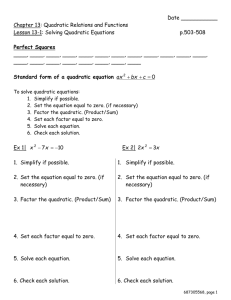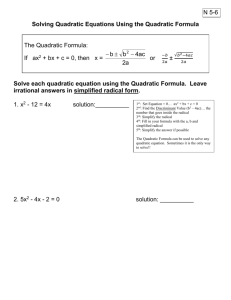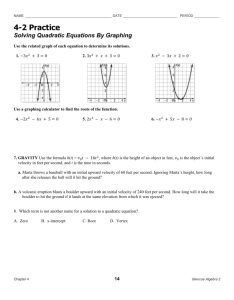Overview - Connecticut Core Standards
advertisement
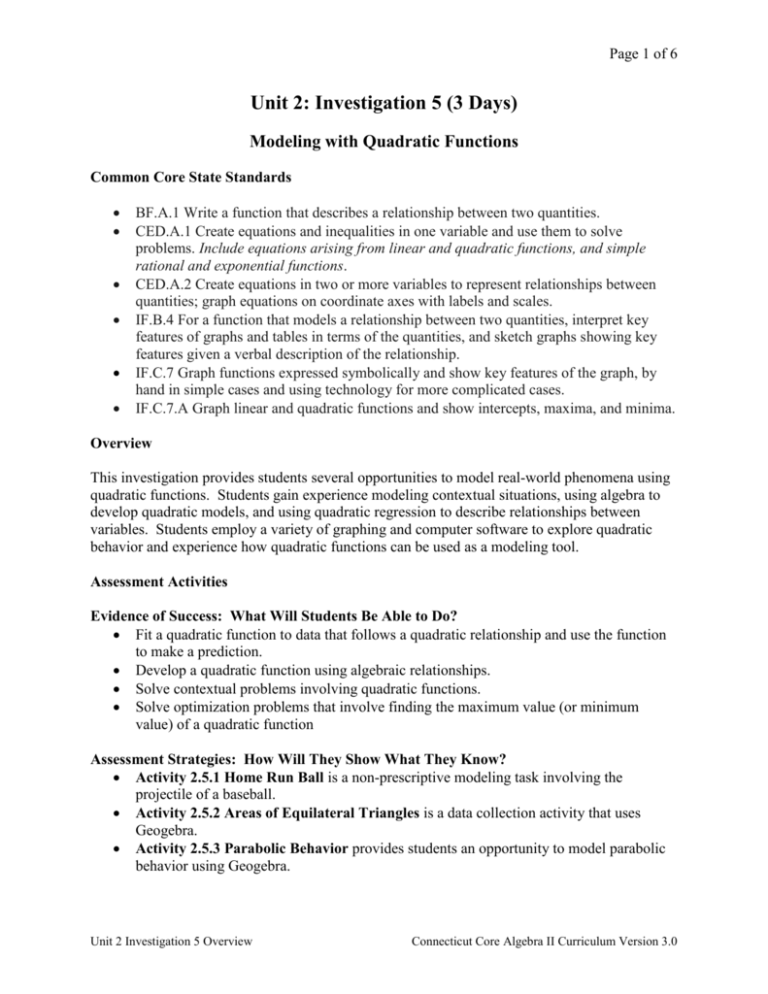
Page 1 of 6 Unit 2: Investigation 5 (3 Days) Modeling with Quadratic Functions Common Core State Standards BF.A.1 Write a function that describes a relationship between two quantities. CED.A.1 Create equations and inequalities in one variable and use them to solve problems. Include equations arising from linear and quadratic functions, and simple rational and exponential functions. CED.A.2 Create equations in two or more variables to represent relationships between quantities; graph equations on coordinate axes with labels and scales. IF.B.4 For a function that models a relationship between two quantities, interpret key features of graphs and tables in terms of the quantities, and sketch graphs showing key features given a verbal description of the relationship. IF.C.7 Graph functions expressed symbolically and show key features of the graph, by hand in simple cases and using technology for more complicated cases. IF.C.7.A Graph linear and quadratic functions and show intercepts, maxima, and minima. Overview This investigation provides students several opportunities to model real-world phenomena using quadratic functions. Students gain experience modeling contextual situations, using algebra to develop quadratic models, and using quadratic regression to describe relationships between variables. Students employ a variety of graphing and computer software to explore quadratic behavior and experience how quadratic functions can be used as a modeling tool. Assessment Activities Evidence of Success: What Will Students Be Able to Do? Fit a quadratic function to data that follows a quadratic relationship and use the function to make a prediction. Develop a quadratic function using algebraic relationships. Solve contextual problems involving quadratic functions. Solve optimization problems that involve finding the maximum value (or minimum value) of a quadratic function Assessment Strategies: How Will They Show What They Know? Activity 2.5.1 Home Run Ball is a non-prescriptive modeling task involving the projectile of a baseball. Activity 2.5.2 Areas of Equilateral Triangles is a data collection activity that uses Geogebra. Activity 2.5.3 Parabolic Behavior provides students an opportunity to model parabolic behavior using Geogebra. Unit 2 Investigation 5 Overview Connecticut Core Algebra II Curriculum Version 3.0 Page 2 of 6 Activity 2.5.4 Historic Hotels is a non-prescriptive modeling task centered on identifying the daily price of a hotel room that will maximize a hotel’s daily profit. Exit Slip 2.5.1 asks students to create a quadratic function given three ordered pairs and find the vertex of the function. Exit Slip 2.5.2 asks students to model a contextual situation involving cost-revenueprofit relationship with a quadratic function. Exit Slip 2.5.3 asks students to use a quadratic model to find the maximum area of a rectangular region with fixed perimeter. Journal Entry 1 asks students to describe a real-world situation that can be modeled with a quadratic function. Journal Entry 2 asks students to describe the steps in a mathematical modeling process. Launch Notes This investigation begins with an exploration of the quadratic behavior of a home run ball. Begin class by showing students a video clip of a home run. (David Ortiz’s grand slam home run at Fenway Park in the 2013 American League Championship is a good example. https://www.youtube.com/watch?v=HJyxzaLNlNw.) Instruct students to imagine the flight of the baseball. At this time it is important for students to recognize that the baseball vertical position rises and falls in a manner similar to a parabola bending downward. After students view the video, ask students to describe the variables and mathematical relationships present in the video. For example, you can use the following prompts: What could we describe about this event mathematically? Possible answers include: movement of ball, speed of ball, height of ball, time it takes for ball to hit ground. What variables and relationships between variables did we observe? Possible answers include: height of the ball over time; ball’s distance from home plate over time; speed of ball over time. Following the video and discussion distribute Activity 2.5.1. This modeling activity allows for a variety of solution and solution approaches. Teaching Strategies I. Activity 2.5.1 Home Run Ball is a non-prescriptive modeling task involving the projectile of a baseball. After distributing the activity, highlight the key steps in solving a modeling task by showing students the following modeling diagram on the board. Briefly explain each step in the modeling diagram. Unit 2 Investigation 5 Overview Connecticut Core Algebra II Curriculum Version 3.0 Page 3 of 6 Modeling Diagram The problem situation in this activity focuses student attention on establishing quadratic relationships between variables and fitting a quadratic function to data in a real-world context. The problem provides information on vertical distances above the ground and horizontal distances from home plate. By assigning x the horizontal distance between the ball and home plate, and y the vertical distance between the ball and the ground, students can create ordered pairs that describe a possible flight path; these ordered pairs can then be fitted by a quadratic function. Other variable assignments are possible but there is less information available in the problem to support these assignments. Students only need three ordered pairs to create a quadratic function; they can employ a variety of methods to construct the quadratic function that fits their data points. Possible methods include: (1) Choosing a point for the y-intercept, using it to find the parameter c of the standard quadratic equation 𝑦 = 𝑎𝑥 2 + 𝑏𝑥 + 𝑐, and then using two additional points to find parameters b and c. (2) Solving a system of three linear equations in three unknowns to find the parameters a, b and c or the parameters a, h, and k. (3) Choosing a point for the vertex (h, k), using the parameters h and k and an additional point to construct a quadratic equation in vertex form 𝑦 = 𝑎(𝑥 − ℎ)2 + 𝑘, and then adjusting the parameter a to obtain a valid quadratic model. After students have had an opportunity to work on their models, have students share their models and approaches for creating models with the entire class. Differentiated Instruction (For Learners Needing More Assistance) Activity 2.5.1a Home Run Ball is a modified version of Activity 2.5.1 that contains scaffolds; the scaffolds provide students guidance on how to develop and explore a quadratic model to model the parabolic behavior of a baseball. Group Activity Assign students into groups of three or four to complete Activity 2.5.1. Instruct students to discuss the problem situation so all members of the group understand the objective of the modeling task. Unit 2 Investigation 5 Overview Connecticut Core Algebra II Curriculum Version 3.0 Page 4 of 6 II. Activity 2.5.2 Areas of Equilateral Triangles is a data collection activity that uses Geogebra. Students use Geogebra to create an equilateral triangle from the radii and intersection of two circles. They collect data on the side length and area of equilateral triangles of various sizes, develop a quadratic-regression model of the data, and graphically compare the regression model to the graph of the algebraic equation for the area of an equilateral triangle in terms of its side length. This activity requires students to have access to a computer. III. Activity 2.5.3 Parabolic Behavior provides students an opportunity to model parabolic behavior using Geogebra. Prior to coming to class, students are instructed to take a digital picture of a real-world object that shows a quadratic relationship and electronically save the image to their email account as a jpg or gif file. In class, students will open up a Geogebra file that is preloaded with sliders for the parameters (a, h, k) of the quadratic function 𝑦 = 𝑎(𝑥 − ℎ)2 + 𝑘. Students upload their image into the worksheet and adjust the sliders to develop a quadratic function that models the image. After developing their quadratic function, students are asked to explain how they adjusted the parameters (a, h, k) to fit the curve to the image, to convert their function from vertex form to standard form, and to find the vertex of their function using the vertex formula. This activity requires that each student have access to a computer. Possible images that exhibit quadratic behavior are images of bridges, archways, water fountains. Differentiated Instruction (Enrichment) In Activity 2.5.3, have students go online to research how to develop a function whose parameters are controlled by sliders and have them create sliders for the parameters (a, h, k) of the quadratic function 𝑦 = 𝑎(𝑥 − ℎ)2 + 𝑘. IV. Activity 2.5.4 Historic Hotels is a non-prescriptive modeling task centered on identifying the daily price of a hotel room that will maximize a hotel’s daily profit. Students are provided an opportunity to reason about the cost-revenue-profit relationship, develop functions to describe these variables based on the given information, establish a quadratic function for daily profit, and find the solution that maximizes the profit. Group Activity Assign students into groups of three or four to complete Activity 2.5.4. Instruct students to discuss the problem situation so all members of the group understand the objective of the modeling task. Differentiated Instruction (For Learners Needing More Assistance) Activity 2.5.4a Historic Hotels is a modified version of Activity 2.5.4 that contains scaffolds; the scaffolds provide students guidance on how to develop a daily profit function and explore the function to obtain the optimal solution to the problem. Journal Entry 1 asks students to describe a real-world situation that can be modeled with a quadratic function. This should be assigned after Activity 2.5.3. Unit 2 Investigation 5 Overview Connecticut Core Algebra II Curriculum Version 3.0 Page 5 of 6 Students may describe the behavior of a falling object, or an object that travels upward and then downward. Journal Entry 2 asks students to describe the steps in a mathematical modeling process. Students may describe the process of carefully examining a real-world situation, defining variables to represent objects of interest, creating mathematical relationships between the variables, establishing a mathematical model, using the mathematical model to develop results, and evaluating the reasonableness of the model and results. This can be assigned after students have been introduced to and experienced the modeling process. Vocabulary Cost Function Mathematical modeling Mathematical model Modeling diagram Parabola Parabolic Parametric equations Profit Function Revenue Function Quadratic regression Vertex Resources and Materials Students will only do 2.5.1 or 2.5.1a; or 2.5.4 or 2.5.4a. In the interest of time, or due to the lack of computer availability, omit one of the four activities. Activity 2.5.1 Home Run Ball Activity 2.5.1a Home Run Ball is a modified version of Activity 2.5.1 that contains scaffolds; Activity 2.5.2 Areas of Equilateral Triangles Activity 2.5.3 Parabolic Behavior Activity 2.5.4 Historic Hotels Activity 2.5.4a Historic Hotels is a modified version of Activity 2.5.4 that contains scaffolds; Video of David Ortiz’s grand slam home run at Fenway Park in the 2013 American League Championship https://www.youtube.com/watch?v=HJyxzaLNlNw TI-83 Graphing Calculator Digital Camera Geogebra ParabolicBehavior Geogebra File Don’t Teach Technology, Teach with Technology, Mathematics Teacher, Vol. 93 (7), October 2000. (Supported the development of Activity 2.5.2) Unit 2 Investigation 5 Overview Connecticut Core Algebra II Curriculum Version 3.0 Page 6 of 6 Digital Images + Interactive Software = Enjoyable, Real Mathematics Modeling, Mathematics Teacher, Vol. 101 (8), April 2008. (Supported the development of Activity 2.5.3) Unit 2 Investigation 5 Overview Connecticut Core Algebra II Curriculum Version 3.0
